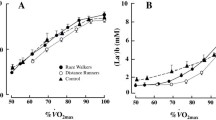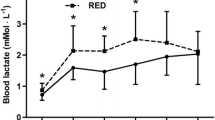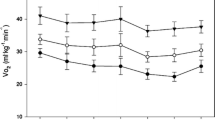Abstract
The purpose of this study was to investigate the influences of treadmill gradients on the rating of perceived exertion (RPE) at two fixed blood lactate concentrations ( [La−]b). Ten subjects performed three different incremental treadmill protocols by running either uphill (concentrically-biased), downhill (eccentrically-biased), or on the flat (non-biased). Individual data of each protocol were interpolated to reflect [La−]b corresponding to 2.0 and 4.0 mmol·l−1. At 2.0 mmol·l−1 [La− b, RPE and treadmill speed during downhill running were greater than during level running which was greater than during uphill running (p < 0.05) . Also, the downhill heart rate (HR) was greater than the uphill HR, and downhill minute ventilation (\(\dot V_E \)) was greater than the level\(\dot V_E \). Treadmill speed was the only measure at 4.0 mmol·l−1 [La−]b to differ between gradients. There was a moderate correlation of RPE with HR at both [La−]b (r = 0.73 at 2.0 mmol·l−1;r = 0.48 at 4.0 mmol·l−1) while treadmill speed was moderately correlated with RPE only at 2.0 mmol·l−1 [La−]b (r = 0.70). The results of this study demonstrated that the degree of eccentric-bias during running exercise is an influence of perceived exertion at a moderate but not at a high exercise intensity.
Similar content being viewed by others
References
Borg GAV (1982) Physiological bases of perceived exertion. Med Sci Sports Exerc 14:377–383
Cafarelli E (1982) Peripheral contributions to the perception of effort. Med Sci Sports Exerc 14:382–389
Cafarelli E, Noble BJ (1976) The effect of inspired carbon dioxide on subjective estimates of exertion during exercise. Ergonomics 19:581–589
Carton RL, Rhodes EC (1985) A critical review of the literature on ratings scales for perceived exertion. Sports Med 2:198–222
DeMello JJ, Cureton KJ, Boineau RE, Singh MM (1987) Ratings of perceived exertion at the lactate threshold in trained and untrained men and women. Med Sci Sports Exerc 19:354–362
Ekblom B, Goldbarg AN (1971) The influence of physical training and other factors on subjective rating of perceived exertion. Acta Physiol Scand 83:399–406
Henriksson J, Knuttgen H, Bonde-Peterson T (1972) Perceived exertion during exercise with concentric and eccentric muscular contractions. Ergonomics 15:537–544
Hetzler RK, Seip RL, Boutcher SH, Pierce E, Snead D, Weltman A (1991) Effect of exercise modality on ratings of perceived exertion at various lactate concentrations. Med Sci Sports Exerc 23:80–87
Hill DW, Cureton KJ, Grisham SC, Collins MA (1987) Effect of training on the rating of perceived exertion at the ventilatory threshold. Eur J Appl Physiol 56:206–211
Horstman DH, Weiskopf R, Robinson S (1978) The nature of the perception of effort at sea level and high altitude. Med Sci Sports 11:150–154
Jackson AS, Pollock ML (1978) Generalized equations for predicting body density of men. Br J Nutr 40:497–504
Jackson AS, Pollock ML, Ward A (1980) Generalized equations for predicting body density of women. Med Sci Sports Exerc 12:175–182
Kostka CE, Cafarelli E (1982) Effect of pH on sensation and vastus lateralis EMG during cycling exercise. J Appl Physiol 52:1181–1185
Löllgen H, Ulmer H-V, Gross R, Wilbert G, Nieding Gv (1975) Methodical aspects of perceived exertion rating and its relation to pedalling rate and rotating mass. Eur J Appl Physiol 34:205–215
Mihevic PM (1981) Sensory cues for perceived exertion: a review. Med Sci Sports Med 13:150–163
Morgan WP (1994) Psychological components of effort sense. Med Sci Sports Exerc 26:1071–1077
Morgan WP, Pollock ML (1977) Psychological characterization of the elite distance runner. Ann NY Acad Sci 301:382–403
Nardone A, Schieppati M (1988) Shift of activity from slow to fast muscle during voluntary lengthening contractions of the triceps surae muscles in humans. J Physiol 395:363–381
Nardone A, Romanò C, Schieppati M (1989) Selective recruitment of high-threshold human motor units during voluntary isotonic lengthening or active muscles. J Physiol 409:451–471
Pandolf KB (1983) Advances in the study and application of perceived exertion. In: Terjung R (ed) Exercise and sports sciences reviews, vol 11. Franklin Institute Press, Philadelphia, Pa, pp 118–158
Pandolf K, Cafarelli E, Noble B, Metz K (1972) Perceptual responses during prolonged work. Percept Mt Skills 35:975–985
Pandolf KB, Kamon E, Noble BJ (1978) Perceived exertion and physiological responses during negative and positive work in climbing a laddermill. J Sports Med Phys Fitness 18:227–236
Robertson RJ (1982) Central signals of perceived exertion during dynamic exercise. Med Sci Sports Exerc 14:390–396
Robertson RJ, Gillespie RL, McCarthy J, Rose KD (1979) Differentiated perceptions of exertion II. Relationship to local and central physiological responses Percept Mot Skills 49:691–697
Robertson RJ, Falkel JE, Drash AL, Swank AM, Metz KF, Spungen SA, LeBoeuf JR (1986) Effect of blood pH on peripheral and central signals of perceived exertion. Med Sci Sports Exerc 18:114–122
Saltin B, Åstrand P-O (1967) Maximal oxygen uptake in athletes. J Appl Physiol 23:353–358
Sargeant AJ, Davies CTM (1973) Perceived exertion during rhythmic exercise involving different muscles masses. J Hum Ergot 2:3–11
Scip RL, Snead D, Pierce EF, Stein P, Weltman A (1991) Perceptual responses and blood lactate concentration: effect of training state. Med Sci Sports Exerc 23:88–92
Siri WE (1956) Gross composition of the body. In: Laurence J, Tobias CA (eds) Advances in biological and medical physics. Academic Press, New York, pp 239–280
Skinner JS, Hustler R, Bergstetnova V, Buskirk ER (1973) Perception of effort during different types of exercise and under different environmental conditions. Med Sci Sports 5:110–115
Stamford BA, Noble BJ (1974) Metabolic cost and perception of effort during bicycle ergometer work performance. Med Sci Sports 6:226–231
Steed J, Gaesser GA, Weltman A (1994) Rating of perceived exertion and blood lactate concentration during submaximal running. Med Sci Sports Exerc 26:797–803
Watt B, Grove R (1993) Perceived exertion: antecedents and applications. Sports Med 15:225–241
Author information
Authors and Affiliations
Rights and permissions
About this article
Cite this article
Kolkhorst, F.W., Mittelstadt, S.W. & Dolgener, F.A. Perceived exertion and blood lactate concentration during graded treadmill running. Europ. J. Appl. Physiol. 72, 272–277 (1996). https://doi.org/10.1007/BF00838651
Accepted:
Issue Date:
DOI: https://doi.org/10.1007/BF00838651




